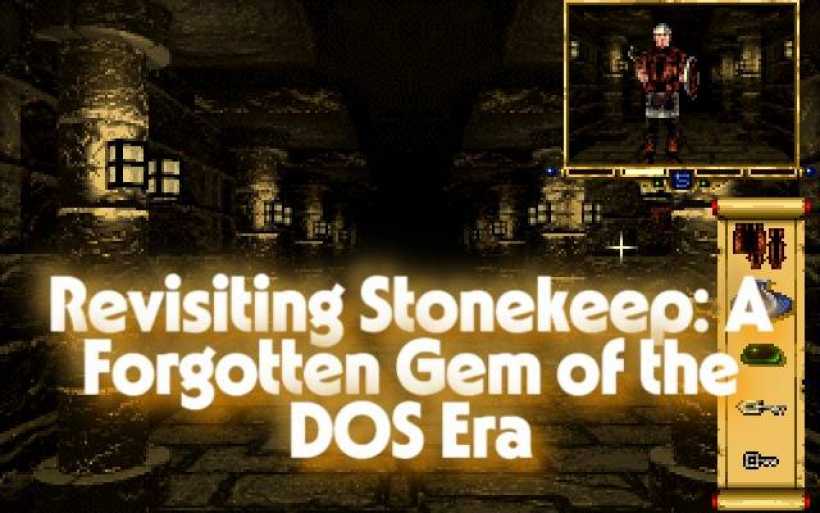When you think of classic RPGs from the '90s, titles like Baldur's Gate, Ultima, or Might and Magic might come to mind. But tucked away in the annals of gaming history is a dungeon crawler that dared to be different: Stonekeep. Released in 1995 by Interplay Productions, this game combined ambitious storytelling, innovative gameplay, and cinematic flair—making it one of the most memorable RPGs of its time, even if it doesn't always get the recognition it deserves today.
The Premise: A Hero Rises from the Ruins
At its heart, Stonekeep tells the story of Drake, the lone survivor of the fortress Stonekeep, which is destroyed in the opening cinematic. Guided by the goddess Thera, Drake embarks on a quest through sprawling underground dungeons to free imprisoned gods and ultimately defeat the dark deity, Khull-Khuum. The setup might sound familiar—one hero against the forces of evil—but the way the game presents this tale is what made it stand out in its era.
Cinematics Ahead of Their Time
One of the defining features of Stonekeep was its cinematic presentation. The game featured digitized actors and live-action cutscenes, seamlessly woven into the gameplay. For players in the mid-'90s, this was groundbreaking. Watching full-motion video (FMV) sequences in an RPG felt like stepping into an interactive movie—a huge step up from the static dialogue boxes most games offered.
Of course, technology has come a long way since then, but back then these visuals were jaw-dropping and gave Stonekeep an almost mystical quality.
Innovative Gameplay Mechanics
Unlike traditional turn-based RPGs, Stonekeep used a real-time combat system combined with tile-based dungeon crawling. You moved step by step through labyrinths, battling monsters, avoiding traps, and solving puzzles. The mechanics were simple to learn but kept you engaged throughout the adventure.
Perhaps the most unique element was the rune-based magick system. Instead of learning spells outright, you collected runes representing different magical languages—Mannish, Fae, Throggish, and Meta. By inscribing these runes onto a runestaff, you could craft spells on the fly, experimenting with combinations to unlock devastating effects. This sense of discovery added real depth and creativity to the magic system.
Development: Ambition Meets Challenge
Stonekeep was not an easy game to bring to life. Interplay reportedly spent five years and nearly $5 million developing it—an astronomical figure for the time. Much of that budget went into its cinematic intro and digitized assets. The result was a game that, at launch, felt like a technical marvel, though the long production cycle meant that some mechanics were already starting to feel dated by the time it hit store shelves.
Still, for those who experienced it in 1995, it left an impression. Players often recall being "blown away" by its graphics and immersive design.
Playing Stonekeep Today
Fast-forward to today, and you don't need a dusty DOS computer to experience Stonekeep. Thanks to DOS emulation, you can play a reduced browser version directly online. The web version captures much of the game's charm, though it strips away some of the video and FMV sequences to keep file sizes manageable.
If you want the full version with all the cinematics intact, you can visit the blog linked on Lemon Web Solutions, where the complete package is available for download. This gives you the true Stonekeep experience—complete with its ambitious cutscenes and atmosphere.
Download Stonekeep and Play on Your Own Computer
If you'd like to experience Stonekeep in all its original glory, you can download the full CD version of the game. This edition includes everything the browser-based emulation trims down—full-motion video cutscenes, complete audio, and all in-game assets. To make things even better, I've included a final level save file, so if you'd like to jump straight into the ending or simply explore without grinding, you can do so right away.C:\Games\Stonekeep).dosbox.conf file and scroll to the [autoexec] section at the bottom.mount C "Stonekeep"
C:
cd \
call SK.BAT
exit
Once that's set, simply run DOSBox, and Stonekeep will launch automatically—no extra typing required. From there, you'll be able to enjoy the full cinematic experience and relive this classic dungeon crawler the way it was originally meant to be played.
Why Stonekeep Still Matters
Even though Stonekeep doesn't always get mentioned in the same breath as other RPG titans, it occupies a unique place in gaming history. It represents a time when developers were experimenting boldly, blending storytelling with technology in ways players hadn't seen before.
For retro gamers, it's more than just nostalgia—it's a chance to revisit a piece of RPG history that dared to push boundaries, even if it stumbled in places. Whether you're reliving the magic or discovering it for the first time, Stonekeep is worth exploring, if only to appreciate the bold risks Interplay took during a golden age of PC gaming.
Final Thoughts
Stonekeep may not be perfect, but it's a fascinating window into the experimental spirit of mid-'90s RPGs. Its atmosphere, unique magick system, and ambitious cinematics ensured it stood out from the crowd, even if it didn't achieve mainstream success. Today, thanks to DOS emulators and fan communities, this classic dungeon crawler has a second life—and remains a game well worth revisiting.
So whether you're playing the browser-based emulation for a quick trip down memory lane or diving into the full version with FMV glory, Stonekeep is a reminder of just how creative—and risky—game development could be in the '90s.





Comments